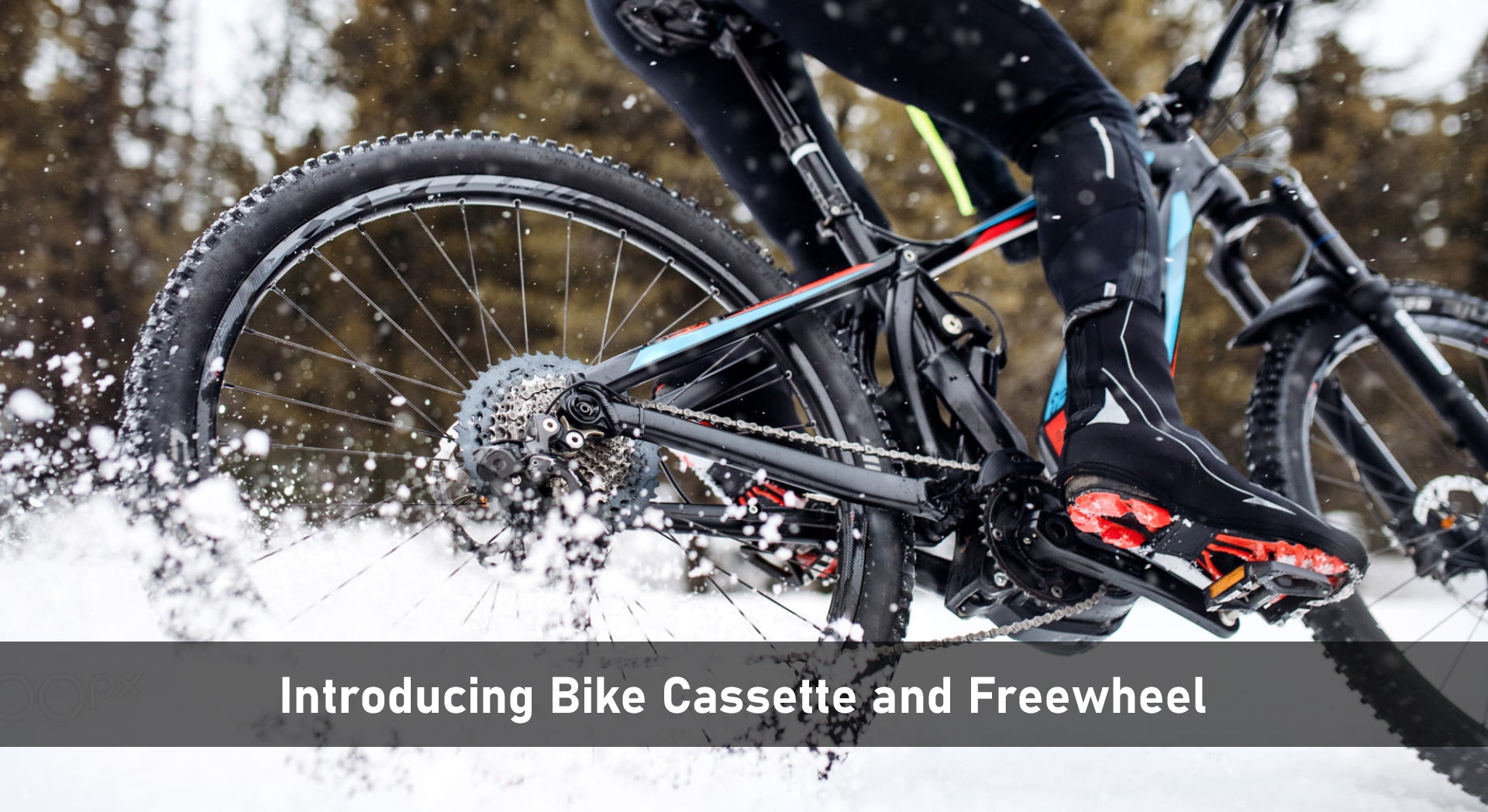Qu'est-ce qu'une cassette ?
Dans le monde du vélo, une cassette désigne un ensemble de vitesses reliées au corps de roue libre de la roue arrière. Elle fait partie intégrante des vélos à plusieurs vitesses, contenant plusieurs vitesses de différentes tailles que les cyclistes peuvent sélectionner à l'aide du dérailleur pour s'adapter à diverses conditions de conduite et à différents terrains.
Une cassette classique se compose généralement de plusieurs pignons fixés sur un support commun. Chaque pignon varie en taille, les plus petits offrant des vitesses plus élevées et les plus grands des vitesses plus basses. En ajustant la position du dérailleur arrière, les cyclistes peuvent déplacer la chaîne d'un pignon à l'autre, réalisant ainsi des changements de vitesse.
Le choix d'une cassette de vélo peut être personnalisé en fonction des préférences personnelles et des besoins du cycliste. Par exemple, un pignon plus grand peut offrir plus de puissance en montée sur les collines, tandis qu'un pignon plus petit peut offrir des vitesses plus élevées sur terrain plat.
Comment fonctionne une cassette ?
Le fonctionnement d'une cassette de vélo implique le corps de roue libre sur la roue arrière, le dérailleur arrière et la chaîne qui y est reliée. Voici un aperçu de base du fonctionnement d'une cassette :
- Roue libre : La roue arrière d'un vélo est équipée d'une roue libre, un dispositif monté sur le moyeu qui permet au pneu de rouler librement lorsque les pédales ne sont pas en mouvement. Un écrou spécial sur la roue libre la relie à la cassette.
- Ensemble de pignons (cassette) : L'ensemble de pignons se compose de plusieurs engrenages de différentes tailles, fixés à « l'écrou » sur le moyeu libre, formant un ensemble unifié.
- Chaîne : La chaîne du vélo relie le pédalier avant et le pignon arrière (cassette). La longueur et la tension de la chaîne sont réglées par les dérailleurs avant et arrière.
- Dérailleurs : Les dérailleurs avant et arrière permettent de passer du pédalier avant au pignon arrière. Lorsque le cycliste actionne le levier de vitesses, les dérailleurs guident la chaîne d'un pignon à l'autre.
Processus de changement de vitesse : lorsque le cycliste pédale, la chaîne entraîne la rotation du pignon. Grâce aux réglages des dérailleurs, les cyclistes peuvent sélectionner différentes vitesses, offrant des vitesses plus élevées ou une plus grande puissance de montée pour s'adapter à différents terrains et situations de conduite.
Qu'est-ce qu'une roue libre ?
Une roue libre est un dispositif situé sur la roue arrière d'un vélo qui permet au pneu de rouler librement lorsque le vélo ne pédale pas, sans affecter la rotation des pédales et des vitesses. Il permet aux cyclistes de rouler sans effort lorsque les pédales sont immobiles.
Les principaux composants d'une roue libre comprennent :
- Pignons : Il s'agit d'un ensemble d'engrenages reliés à la roue libre, comprenant généralement plusieurs pignons de tailles différentes, formant une unité amovible. Ces pignons sont souvent conçus comme une seule unité et installés sur la roue libre.
- Corps de roue libre : Le corps de roue libre est un dispositif qui permet aux engrenages de tourner librement lorsque le cycliste arrête de pédaler, sans gêner le roulement du pneu. Le corps de roue libre contient un mécanisme interne avec des roulements et des ressorts qui permettent aux engrenages de tourner librement dans un sens tout en restant connectés à la roue libre dans l'autre.
La roue libre est généralement intégrée au moyeu, montée sur la roue arrière du vélo. Alors que les systèmes à roue libre étaient courants dans le passé, les vélos modernes utilisent plus fréquemment le système à roue libre, qui partage les principes fondamentaux avec la roue libre mais bénéficie d'une conception plus moderne et de certains avantages. Dans le système à roue libre, la roue libre et les roulements sont montés sur un composant indépendant appelé corps de roue libre, ce qui facilite le remplacement du pignon sans remplacer la roue libre entière.
Distinguer les deux


La roue libre et la cassette sont toutes deux des composants de la roue arrière d'un vélo liés au système de transmission, et elles présentent des différences significatives en termes de structure et de fonctionnement.
- Position structurelle :
Roue libre : La roue libre comprend généralement un jeu de pignons directement vissé sur le moyeu.
Cassette : Le jeu de pignons de la cassette est séparé et se monte généralement directement sur le corps de roue libre, un composant qui peut tourner librement tandis que le jeu de pignons peut être détaché et remplacé.
- Remplacement et entretien :
Roue libre : Dans le système à roue libre, le remplacement du jeu de pignons nécessite souvent de changer l'ensemble de l'unité de roue libre.
Cassette : Dans le système à cassette, les pignons individuels peuvent être remplacés sans changer l'ensemble du corps de roue libre, offrant une plus grande flexibilité et une meilleure rentabilité en matière de maintenance.
- Normalisation et compatibilité :
Roue libre : La roue libre manque de standardisation robuste dans sa conception, ce qui entraîne des problèmes de compatibilité potentiels entre différentes marques et modèles.
Cassette : Le système de cassette est plus facilement standardisé, adoptant souvent les normes de l'industrie, facilitant l'utilisation de cassettes de différents fabricants sur le même corps de roue libre.
- Époque et popularité :
Roue libre : Les systèmes de roue libre étaient plus courants dans le passé, mais sont relativement moins répandus sur les vélos modernes.
Cassette : Les systèmes à cassette sont les plus courants dans les vélos modernes, en particulier dans les systèmes de transmission hautes performances et à plusieurs vitesses.
En résumé, le système à cassette est plus flexible, plus facile à entretenir et offre une meilleure compatibilité que le système à roue libre. L'utilisation de systèmes à roue libre dans l'industrie du vélo est devenue relativement rare, tandis que le système à cassette s'adapte mieux à la conception des vélos modernes et aux besoins de conduite.
Comprendre l'importance d'identifier la cassette ou le système de roue libre de votre vélo
Il est essentiel pour les cyclistes de savoir si leur vélo est équipé d'un système à cassette ou à roue libre. Cette compréhension concerne la conception de la roue arrière et du système de transmission, influençant directement l'entretien ultérieur, les mises à niveau et le choix des accessoires appropriés.
- Entretien et remplacement :
Cassette : Si votre vélo utilise un système à cassette, la séparation du jeu de pignons et du corps de roue libre permet une maintenance plus flexible. Vous pouvez remplacer les pignons individuellement sans changer l'ensemble du corps de roue libre, ce qui réduit les coûts de maintenance et offre davantage d'options.
Roue libre : Dans un système à roue libre, les pignons et le corps de roue libre forment une seule unité, ce qui peut nécessiter le remplacement de la roue libre dans son intégralité. Cela peut augmenter la difficulté et le coût de la maintenance.
- Mises à niveau et flexibilité :
Cassette : Grâce à la conception du système de cassette, la mise à niveau du jeu de pignons ou le réglage du système d'engrenages deviennent plus simples. Vous pouvez choisir des jeux de pignons avec différents nombres de dents et vitesses pour répondre à différents besoins de conduite.
Roue libre : Dans un système à roue libre, les options de mise à niveau et de réglage sont relativement limitées, car le remplacement de la roue libre entière peut impliquer plus de travail et de coûts.
- Sélection d'accessoires :
Cassette : Comprendre que votre vélo utilise un système de cassette facilite le choix des accessoires compatibles tels que les kits de dérailleur arrière, les paires de roues, etc. Il existe un marché plus large pour les accessoires compatibles avec les systèmes de cassette.
Roue libre : Si votre vélo utilise un système de roue libre, assurez-vous que les accessoires choisis sont compatibles avec ce système de roue arrière pour éviter les décalages et complications futures.
- Réparations et consultations :
Cassette : Lorsque vous entreprenez des réparations ou que vous demandez conseil à des techniciens professionnels, savoir que votre vélo utilise un système à cassette permet des recommandations et une assistance plus précises.
Roue libre : Si des problèmes surviennent, il est essentiel d'informer les techniciens que votre vélo utilise un système de roue libre, car ils peuvent avoir besoin de comprendre la conception spécifique de votre vélo.
En conclusion, il est très important pour les cyclistes de savoir si leur vélo utilise un système à cassette ou à roue libre. Cette connaissance facilite une meilleure gestion et un meilleur entretien du vélo, la sélection d'accessoires adaptés et améliore la flexibilité et le confort pendant les sorties.
Achetez des produits via https://yosepower.com/?ref=FROMLILY et obtenez 10 € de réduction avec ce code de réduction « YOSELILY » !


Partager:
Partager des moments heureux avec des amis : les vélos électriques deviennent un nouveau favori des réseaux sociaux
À la découverte de la polyvalence des vélos électriques